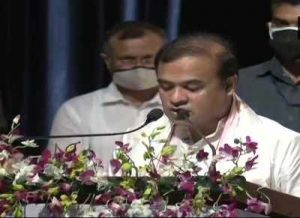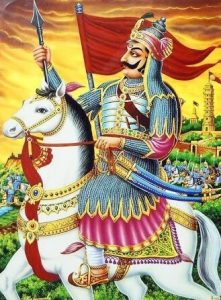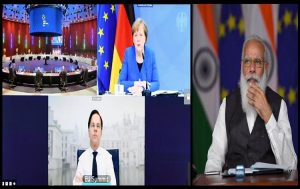Today Current Affairs: 10th May 2021 for UPSC IAS exams, State PSC exams, SSC CGL, State SSC, RRB, Railways, Banking Exam & IBPS, etc
Table of Contents
Himanta Biswa Sarma:15th Chief Minister of Assam:

Himanta Biswa Sarma, the face of the BJP in Northeast India, will be sworn in as the 15th Chief Minister of Assam.
- His name was proposed by outgoing Chief Minister Sarbananda Sonowal.
- BJP retained power in the state along with alliance partners Asom Gana Parishad and UPPL. Dr. Sarma was holding several important portfolios including Health and Finance in the Sarbananda Sonowal government.
- As finance minister, Sarma earned Assam the distinction of being the first state to roll out the GST regime.
Maharana Partap Birth Anniversary: 9th May:

Prime Minister Narendra Modi paid tributes to Maharana Partap on his birth anniversary.
- Pratap Singh popularly known as Maharana Pratap was a king of Mewar, a region in the present-day state of Rajasthan.
- He was the eldest son of Udai Singh II (founder of city of Udaipur).
- Battle of Haldighati: It was fought on 18 June 1576 between the forces Maharana Pratap; and the Mughal emperor Akbar’s forces, led by Man Singh I of Amber. The Mughals were the victors but failed to capture Pratap, who escaped.
- Mughal pressure on Mewar relaxed after 1579 following rebellions in Bengal and Bihar. Taking advantage of the situation, Pratap recovered Western Mewar including Kumbhalgarh, Udaipur and Gogunda. During this period, he also built a new capital, Chavand, near modern Dungarpur.
- Chetak is the name given in traditional literature to the horse ridden by Maharana Pratap at the Battle of Haldighati.
- However, some Historians debate it.
- According to tradition, Chetak, although wounded, carried Pratap safely away from the battle, but then died of his wounds.
- The story is recounted in court poems of Mewar from the 17th century onwards.
- Pratap Gaurav Kendra: It is a tourist spot at Tiger Hill in Udaipur city, Rajasthan.
- It aims at providing information about Maharana Pratap and the historical heritage of the area with the help of modern technology.
Gopal Krishna Gokhale Birth anniversary:9th May

Prime Minister Narendra Modi paid tributes to Freedom Fighter and social reformer, Gopal Krishna Gokhale, on his birth anniversary.
- Gokhale became a member of the Indian National Congress in 1889. He was the leader of the moderate faction of the Congress party.
- In 1905, he was elected president of the Indian National Congress (Benares Session).
- He played a leading role in bringing about Morley-Minto Reforms, the beginning of constitutional reforms in India.
- Member in British India Legislature: In 1899, Gokhale was elected to the Bombay Legislative Council and in 1901 he was elected to the Imperial Council of the Governor-General of India.
- Servants of India Society: It was formed by him in Pune (Maharashtra) in 1905 to further the expansion of education in India. The Society organized mobile libraries, founded schools, and provided night classes for factory workers.
- Ranade Institute of Economics: In 1908, he founded the ‘Ranade Institute of Economics’.
- Mentor to Gandhi: In his autobiography, Gandhi calls Gokhale his mentor and guide. In 1912, Gokhale visited South Africa at Gandhi’s invitation. He received personal guidance from Gokhale, including a knowledge and understanding of India and the issues confronting common Indians.
- Hitavad: He launched the English weekly newspaper named The Hitavad (The people’s paper) in 1911.
2021 Laureus Sportsman Of The Year:

Spain’s Rafael Nadal was named the 2021 Laureus Sportsman of the year, while fellow tennis player Naomi Osaka won the top women’s honor.
- Japan’s Osaka won her second U.S. Open title last year, while Nadal equalled Roger Federer’s record of 20 Grand Slam titles by claiming his 13th French Open crown.
- Nadal picked up his fourth Laureus honour, having previously scooped the Breakthrough, Comeback, and men’s individual awards.
- German soccer champions Bayern Munich, who won last season’s Champions League, was named the Team of the Year.
- Britain’s Formula One world champion Lewis Hamilton claimed the inaugural Athlete Advocate of the Year Award for his involvement in the fight against racism.
- Tennis legend Billie Jean King was awarded the “Lifetime Achievement Award” by the Laureus Academy.
The Laureus World Sports Awards is an annual award ceremony honoring individuals and teams from the world of sports along with sporting achievements throughout the year. It was established in 1999 by Laureus Sport for Good Foundation.
Debris From A Chinese Rocket Disintegrated Over The Indian Ocean:

Debris from a Chinese rocket made an uncontrolled re-entry into the Earth’s atmosphere and disintegrated over the Indian Ocean, with remnants falling at a location to the west of Maldives.
- The debris came from the upper stage of a Long March 5Brocket– China’s largest– that had been launched into space on April 29 for putting into orbit a core module of the new Tianhe space station, which is expected to become operational in 2022.
- For days, there had been speculation on whether the debris would hit a populated area on the Earth’s surface, leading NASA to criticise China over lack of transparency and for “failing to meet responsible standards”.
- When a rocket is launched, its discarded booster stages re-enter the atmosphere soon after liftoff and harmlessly fall into the ocean– a standard practice.
- In this case, however, a 10-floor large vehicle of the rocket weighing 18 metric tonnes went into orbit along with the section of the under-construction space station that it was carrying.
- While in orbit, this vehicle kept rubbing against the air at the top of the atmosphere, and the resulting friction caused it to start losing altitude. The piece hurtled through a low-Earth orbit at roughly 25,490 km/hr.
- An “uncontrolled re-entry” thus became inevitable, but China did not admit this fact to the world until Sunday, when it said the debris had entered the Earth’s atmosphere over the Mediterranean, flown over the Arabian peninsula, and crashed near the Maldives at 72.47° East and 2.65° North.
- Few expected the debris to harm humans, mainly due to most of it burning up in the atmosphere, as well as the fact that large parts of the Earth are covered by oceans and massive land areas lie uninhabited.
- When rockets carry their payload into space, their booster stages that reach orbit fire the engine again after completing their job so as to drop back to Earth and not remain in orbit.
- Space agencies plan this process to ensure that such rocket parts end up in uninhabited areas, such as the middle of the ocean.
- China chose not to do this for its Long March rocket, leading to its vehicle crashing back uncontrollably. China’s plan to launch 10 more missions like this until 2022 to complete the Tianhe has thus sparked worry that pieces from its rockets could end up causing injuries.
Social Stock Exchanges (SSEs):

A technical group on social stock exchanges (SSEs), constituted by the Securities and Exchange Board of India (SEBI), has recommended that political and religious organizations, trade organizations as well as corporate foundations should not be allowed to raise funds through SSEs.
- Pursuant to an announcement made by the Finance Minister Nirmala Sitharaman in her budget speech for FY 2019-20 regarding Social Stock Exchanges SEBI had constituted a Working group and later a technical group under the chairmanship of Harsh Bhanwala, former chairman of NABARD.
- The technical group report said both For-Profit Enterprise (FPE) and Not for Profit Organisation (NPO) will be eligible to tap the SSE if they are able to show their primary goals are social intent and impact.
- Corporate foundations, political or religious organizations/ activities, professional or trade associations, infrastructure, and housing companies (except affordable housing) will not be permitted on SSE.
- SSE is engaged in at least one of the 15 broad eligible activities. They target underserved or less privileged population segments or regions and should have at least 67 percent of its activities qualifying as eligible activities to the target population.
- The report has also made a list of eligible activities that social enterprises can engage in such as eradicating hunger, poverty malnutrition, and inequality; training to promote rural sports; promoting gender equality by the empowerment of women and LGBTQIA+ communities; slum area development/ affordable housing; forest and wildlife conservation; promoting livelihoods for rural and urban poor; promotion of financial inclusion among others.
- The panel has recommended different modes of fundraising for NPOs and FPEs.
- For NPOs it has recommended fundraising through “equity, zero-coupon zero principal bond, development impact bonds, social impact fund with 100 percent grants-in grants out provision, and donations by investors through mutual funds”.
- For FPEs it has recommended fundraising through equity, debt, development impact bonds, and social venture funds.
India-European Union (EU) Leaders Meeting:

Indian Prime Minister participated in the India-European Union (EU) Leaders Meeting.
- The meeting was held in a hybrid format with the participation of leaders of all the 27 EU Member States as well as the President of the European Council and the European Commission.
- This is the first time that the EU hosted a meeting with India in the EU+27 format.
- The meeting was the initiative of the Portuguese Presidency of the Council of the EU.
Free Trade Negotiations:
- Agreed to relaunch free trade negotiations by resuming talks that were suspended for the Bilateral Trade and Investment Agreement (BTIA).
- India and EU had launched talks for having a wide-ranging Free Trade Agreement (FTA), officially called broad-based BTIA, long ago in 2007.
- The BTIA was proposed to encompass trade in goods, services and investments.
Connectivity Partnership:
- Launched an ambitious and comprehensive ‘Connectivity Partnership’ which is focused on enhancing digital, energy, transport and people-to-people connectivity.
- It is based on the shared principles of social, economic, fiscal, climate and environmental sustainability, and respect for international law and commitments.
- It will catalyse private and public financing for connectivity projects. It will also foster new synergies for supporting connectivity initiatives in third countries, including in the Indo-Pacific.
- Also signed the contract for the second tranche of USD 150 million from the EU for the Pune Metro rail project.
Climate Change:
- Reiterated their commitment to achieving the goals of the Paris Agreement and agreed to strengthen joint efforts for mitigation, adaptation, and resilience to the impacts of climate change, as well as providing means of implementation including finance in the context of the Conference of the Parties (COP 26).
- India welcomed the EU’s decision to join the Coalition for Disaster Resilient Infrastructure (CDRI).
Technology:
- Agreed to enhance bilateral cooperation on digital and emerging technologies such as 5G, Artificial Intelligence (AI), Quantum, and High-Performance Computing including through the early operationalization of the Joint Task Force on AI and the Digital Investment Forum.
Strengthening Partnership:
- Desired to further strengthen the India-EU Strategic Partnership based on a shared commitment to democracy, fundamental freedoms, rule of law, and multilateralism.
- India appreciated the prompt assistance provided by the EU and its member states to combat its second Covid wave.
- India also requested the EU’s support for its joint proposal with South Africa for a Trade-Related Aspects of Intellectual Property (TRIPS) waiver on vaccine production-related patents in the World Trade Organisation (WTO).
- Recently, the US has supported the proposal. However, India failed to secure the support of the European leaders
Post Devolution Revenue Deficit:

The Ministry of Finance has released the second monthly installment of Post Devolution Revenue Deficit (PDRD) Grant of Rs. 9,871 crore for the year 2021-22 to 17 States.
About the Post Devolution Revenue Deficit (PDRD):
- The Centre provides the Post Devolution Revenue Deficit Grant to the States under Article 275 of the Constitution.
- The grants are released as per the recommendations of the Finance Commission in monthly installments to meet the gap in Revenue Accounts of the States post-devolution (of the divisible tax pool of the Centre).
- The 15th Finance Commission has recommended post-devolution revenue deficit grants amounting to about Rs. 3 trillion over the five-year period ending FY26.
- The number of states qualifying for the revenue deficit grants decreases from 17 in FY22, the first year of the award period to 6 in FY26, the last year.
- The eligibility of States to receive this grant and the quantum of the grant was decided by the Commission based on the gap between assessment of revenue and expenditure of the State.
States Recommended for PDRD Grants:
- Over the five-year period, Andhra Pradesh, Assam, Haryana, Himachal Pradesh, Karnataka, Kerala, Manipur, Meghalaya, Mizoram, Nagaland, Punjab, Rajasthan, Sikkim, Tamil Nadu, Tripura, Uttarakhand and West Bengal are recommended to be provided with the deficit grants. The Ministry of Finance has accepted the recommendation.
3rd Arctic Science Ministerial (ASM):

India participated in the 3rd Arctic Science Ministerial (ASM) and shared plans for research and long-term cooperation in the Arctic Region.
- The first two meetings—ASM1 and ASM2—were held in the USA in 2016 and Germany in 2018, respectively.
- The Arctic region comprises the Arctic Ocean and parts of countries such as Canada, Denmark (Greenland), Norway, Russia, USA (Alaska), Finland, Sweden and Iceland.
- These countries together form the core of the Arctic Council, an intergovernmental forum.
- HQ: Norway
Third Arctic Science Ministerial Conference:
- Host Countries: It was jointly organised by Iceland and Japan.
- It was the first Ministerial meeting being held in Asia (Tokyo in Japan).
- Objective: It provides opportunities to various stakeholders, including academia, indigenous communities, governments and policymakers, to enhance collective understanding of the Arctic region, emphasize and engage in constant monitoring, and strengthen observations.
- Theme: ‘Knowledge for a Sustainable Arctic’.
India’s Stand:
- To contribute observing systems in the Arctic, both in-situ and by remote sensing.
- Would deploy open ocean mooring in the Arctic for long-term monitoring of upper ocean variables and marine meteorological parameters.
- The launch of the NISAR (NASA-ISRO Synthetic Aperture Radar) satellite mission, in collaboration with the USA, is underway.
Contributions to the Sustained Arctic Observational Network (SAON) would continue.
Animal Corridor:

There are cases of clearance of forest land, digging, and construction activities on at least three animal corridors within the eco-sensitive zone of the Kaziranga National Park and Tiger Reserve.
- The Supreme Court of India in its 2019 order had said that “No new construction shall be permitted on private lands which form part of the nine identified animal corridors.”
About the Animal Corridor:
- Wildlife or animal corridors are meant to ensure safe passage for animals between two isolated habitats.
- In wildlife parlance, corridors are mainly of two types: functional and structural.
- Functional corridors are defined in terms of functionality from the perspective of the animal (basically areas where there have been recorded movement of wildlife).
- Structural corridors are contiguous strips of forested areas and structurally connect the otherwise fragmented blocks of the landscape.
- When structural corridors are affected by human anthropogenic activities, functional corridors automatically widen because of animal use.
Kaziranga Animal Corridor:
- A special committee formed by the Supreme Court in its report had recommended the delineation of nine animal corridors in Kaziranga National Park (KNP).
The nine identified animal corridors are:
- Amguri, Bagori, Chirang, Deosur, Harmati, Hatidandi and Kanchanjuri are in Nagaon district, and Haldibari and Panbari corridors are in Golaghat district of Assam.
- The nine corridors that already exist behave as functional corridors, but according to the new recommendation, the corridors will act as both structural and functional, on the basis of need.
- The report suggested that structural corridors should be made free of all human induced disturbances except for the forestry and wildlife management practices.
- On the other hand, functional corridors (which might become important when structural corridors are disturbed), can have regulated multi-use with restrictions on land use change.
Significance of Animal Corridors:
- These corridors are crucial for the rhinos, elephants, tigers, deer, and other animals that escape a flooded Kaziranga during the monsoon months for the safety of the hills of Karbi Anglong district beyond the highway skirting the southern boundary of the tiger reserve.
- Once the rain clears, the animals make their way back to the grasslands.
Kaziranga National Park and Tiger Reserve:
- It is located in the State of Assam and covers 42,996 Hectare (ha).
- It is the single largest undisturbed and representative area in the Brahmaputra Valley floodplain.
- It was declared as a National Park in 1974.
- It has been declared a tiger reserve since 2007.
- It was declared a UNESCO World Heritage Site in 1985.
- It is recognized as an Important Bird Area by BirdLife International.
- It is the home of the world’s most one-horned rhinos
Mucormycosis Or Black Fungus:

A number of Covid-19 patients are developing a serious fungal infection known as Mucormycosis also called black fungus.
Mucormycosis:
- It is a serious but rare fungal infection caused by a group of molds called mucormycetes, which is abundant in the environment.
- It mainly affects people who have health problems or take medicines that lower the body’s ability to fight germs and sickness.
- The types of Mucormycosis are: Rhinocerebral (Sinus and Brain), Pulmonary (Lung), Gastrointestinal, Cutaneous (Skin), and disseminated Mucormycosis.
Transmission:
- It occurs through inhalation, inoculation, or ingestion of spores from the environment.
- Mucormycosis does not spread between people or between people and animals.
Symptoms:
- These include pain and redness around eyes and/or nose, fever, headache, coughing, shortness of breath, bloody vomits, and altered mental status.
- Warning signs can include toothache, loosening of teeth, blurred or double vision with pain.
Prevention:
- Avoiding areas with a lot of dust like construction or excavation sites, avoiding direct contact with water-damaged buildings and flood water after hurricanes and natural disasters and avoiding activities that involve close contact to soil.
Treatment:
- Mucormycosis needs to be treated with prescription antifungal medicine.
- In some cases, it can require surgery.
Drug 2-deoxy-D-glucose (2-DG):

The DCGI has granted emergency use approval to DRDO’s 2-DG drug for treatment in moderate to severe cases of Covid-19.2-DG helps in the faster recovery of hospitalized patients and reduces supplemental oxygen dependence.
- The drug 2-deoxy-D-glucose (2-DG) has been developed by DRDO’s Institute of Nuclear Medicine and Allied Sciences (INMAS) in collaboration with Hyderabad-based Dr. Reddy’s Laboritories.
- The drug comes in powder form in a sachet, which is taken orally by dissolving it in water.
- It accumulates in the virus-infected cells and prevents virus growth by stopping viral synthesis and energy production.
- Its selective accumulation in virally infected cells makes this drug unique.
- Clinical trial results have shown that this molecule helps in faster recovery of hospitalized patients and reduces supplemental oxygen dependence, noted the release.




